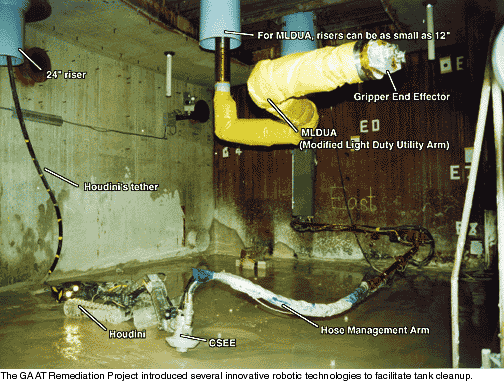|
In the
beginning
|
|||||||||||||||||||||||
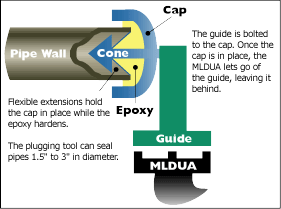 A
number of pipes were used to deliver waste and transfer it among
the gunite tanks. To seal off these internal tank pipes and isolate
the tanks, the Tanks Focus Area teamed with laboratory partners
to develop a Pipe Cutting and Isolation System (Tech
ID 2093). Adapted from inexpensive commercial tools, this
technology was deployed on the MLDUA in Tanks W-6, W-7, W-8, W-9,
and W-10. A
number of pipes were used to deliver waste and transfer it among
the gunite tanks. To seal off these internal tank pipes and isolate
the tanks, the Tanks Focus Area teamed with laboratory partners
to develop a Pipe Cutting and Isolation System (Tech
ID 2093). Adapted from inexpensive commercial tools, this
technology was deployed on the MLDUA in Tanks W-6, W-7, W-8, W-9,
and W-10. |
Confined Sluicing End Effector
(CSEE, Tech
ID 12)—Gripped by either the MLDUA or Houdini, the CSEE uses
rotating, high-pressure water jets to cut part and slurry the sludge
waste. It is coupled to a jet pump and hose system for conveying the
waste up and out of the tank.
Hose Management Arm (HMA)—A companion
arm to the MLDUA, this mechanical follower “swinging arm”
is the waste conveyance system that starts at the CSEE. A jet pump
located inside the HMA deployment mast sucks waste from the CSEE and
pumps it to the end of the HMA and into the flow control box at the
surface.
Beginning in June 1997, these technologies worked together to mobilize
and retrieve the sludge waste and transfer it to GAAT W-9. Here, the
waste was consolidated for conditioning prior to transfer to the stainless
steel Melton Valley Storage Tanks (MVSTs). Additional technologies
were deployed in Tank W-9 to mix the waste and separate dense sludge
particles from the lighter waste fraction.
Waste Conditioning System (Tech
ID 2385)—Designed to keep the waste within transfer specifications,
the system consists of an enclosure for the primary conditioning system
components (samplers and a waste classifier) and a separate Solids
Monitoring Test Loop enclosure containing the solids monitoring instrumentation.
Pulsed-Air Mixer (Tech
ID 1510)—An integral part of the Waste Conditioning System,
this mixer delivers pulses of air from an array of steel discs at
the bottom of the tank. These air pulses create large bubbles that
rise to the waste surface, creating a mixing action among the sludge
and slurry waste. By varying the air pulses, the degree of mixing
is controlled to limit solids entrainment to within transfer specifications.
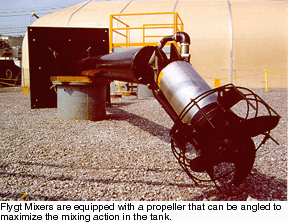
There’s always one “special case” in every story, and this is no exception. In early 1998, remote inspections of Tank W-5 indicated that the interior walls had significantly deteriorated. Chunks of gunite were falling from the walls, exposing the wire mesh used in the construction process. Rather than risking damage to the robotic retrieval equipment, the GAAT team deployed two commercially available Flygt Mixers (Tech ID 2232) to mix and mobilize the waste in Tank W-5 into a transportable slurry. At the completion of retrieval operations in August 1998 using the Flygt Mixers, more than 60% of the residual contamination was removed, leaving a waste heel of less than 2% of the tank volume. As a result of the success in Tank W-5, one of the Flygt Mixers was also deployed in the consolidation tank, W-9, to facilitate mobilization and mixing of sludge waste. |
Heavy Waste Retrieval System (HWRS, Tech ID 2194)—To transfer the final dense sludge out of Tank W-9, the HWRS uses a positive displacement pump in combination with a surge tank and adjacent supernatant reservoir. Together, this equipment provides a means of maintaining continuous flow to the transfer line and keeps solids from settling in the line.
By July 2000, more than 60,000 gallons of sludge was retrieved from
seven gunite tanks, resulting in the transfer of 483,000 gallons of
sludge and process water to the MVSTs in a series of 18 transfers.
The project team then focused on removing the remaining dense sludge
layer from the consolidation tank, W-9. The high concentration of
solids in this tank presented a very real potential for transfer line
plugging during waste delivery to the MVSTs. The team decided to first
transfer the waste from Tank W-9 to the site’s Bethel Valley
Evaporator Service Tanks. Here, the waste was mixed with additional
supernatant and sludge, then transferred to the MVSTs when an acceptable
solids concentration was reached. By September 2000, approximately
53,000 gallons of sludge and supernatant waste was successfully retrieved
from Tank W-9, signaling completion of the majority of the GAAT retrieval
efforts.
What a
load of waste!
At the start of GAAT retrieval in June 1997, more than 300,000 gallons
of supernatant and about 96,000 gallons of sludge waste were stored
in the eight gunite tanks. In just over three years, the GAAT Remediation
Team cleaned all eight tanks to a level the Tennessee
Department of Environment and Conservation deemed acceptable for
closure activities to commence. By September 2000, only 7,500 gallons
of combined sludge and supernatant remained in the tanks, reducing
the curie count from 85,838 curies to just under 4,200 curies. The
table shown summarizes the “before and after” tank waste
volumes and the associated curie levels.
| Curie—a basic unit used to describe the intensity of radioactivity in a material. Curies express the rate at which a radioactive material gives off particles and disintegrates. One curie is the amount of radioactivity in 1 gram of the isotope radium-226. One curie gives off 37 billion disintegrations per second. A typical home smoke detector contains about 1 millionth of a curie of radioactivity. |
Completion of GAAT retrieval represents a significant site milestone toward completing the GAAT Remediation Project. The success of the GAAT project represents a key accomplishment for University of Tennessee-Battelle, Bechtel-Jacobs, TFA, RBX, and other contractor contributors that developed the equipment and supported the retrieval operations. In addition to successfully accelerating cleanup efforts at ORNL, results of the GAAT retrieval activities provide valuable lessons learned and information for other DOE tank sites currently evaluating retrieval options and developing plans for their retrieval projects.
Lessons
learned
As with any large project—especially one involving limited-access
radioactive waste tanks—only so much advance planning can be done.
Over the course of the multiyear remediation project, the project
team encountered numerous instances where the in-tank situation was
not what they expected. This meant regrouping and figuring out how
to approach the problem, while keeping the project schedule in mind.
The team was able to manage these difficulties through operational
efficiencies gained in each successive tank.
The team also benefited from extensive cold-testing conducted in
a nearby test facility. All equipment and modifications were demonstrated
in a nonradioactive environment before deployment in the gunite tanks
to enable the team to check for any operational glitches before contaminating
the equipment. One such case involved the MLDUA.
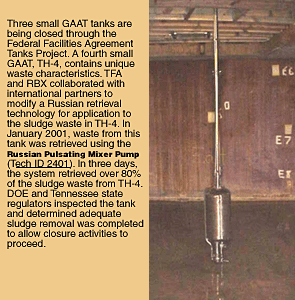
Initial testing of the robotic arm showed that its position control
mechanism was highly sensitive to deviations from the commanded position,
as might occur when trying to push against a fixed obstacle such as
a tank wall. The team devised a method of obtaining samples from the
wall surfaces using a spring-loaded scrape tool held by the MLDUA.
The spring mechanism kept the tool pushed against the wall, while
the arm moved straight up, safely following its commanded positions.
The team also modified the original Houdini vehicle design based
on operational experience in three gunite tanks from June 1997 to
August 1998. During initial deployment, the team encountered significant
problems with operation of the onboard manipulator arm. A new and
improved Houdini-II began in-tank sludge mobilization work in January
1999. The versatility of the Houdini vehicle enabled new tools to
be quickly integrated into the system, based on emerging situations
encountered during the retrieval campaigns.
Originally designed to cut and cap abandoned pipes, the Pipe Cutting and Isolation System (Tech ID 2093) also proved useful for clearing in-tank obstructions to facilitate wall scarification efforts. In addition, an unexpected benefit of the pipe-capping tool was an improvement in the tank vacuum level, reducing the potential for release of airborne contamination.
|
GAAT
Waste Removal Operations Performance Summary (6/97-9/00)
|
|
| Initial Supernatant Volume (Gallons) | 334,507 |
| Initial Sludge Volume (Gallons) | 96,380 |
| Final Supernatant/Sludge Volume (Gallons) | 7,581 |
| Initial Curies | 85,838 |
| Final Curies | 4,173 |
| Water Used (Gallons) | 378,733 |
| Percentage of Waste Removed (Based on Total Tank Volume) | 99.4 |
| Percentage of Curies Removed | 95.2 |
|
Assumptions: |
|
Project closeout and preparing for tank closure
TFA assisted GAAT closure planning efforts early in the project through
the assessment of tank closure options and development of a reducing
grout formulation for tank stabilization. One promising option, called
MultiPoint Grout Injection™
(Tech ID
2368), from Ground Environmental Services was selected on the
basis of its superior ability to mix tank waste with specifically
tailored stabilizing grouts. This technology was cold-tested and proposed
for deployment if significant quantities of waste and radioactivity
remained in the tanks after retrieval. Due to the efficiency of the
waste retrieval operations and the minimal quantity of waste remaining
in the GAATs, the enhanced mixing ability of the MPI™ process
was deemed unnecessary for closure of the GAATs.
The site must now determine a path forward for disposition of the
equipment used in the GAAT Remediation Project. In 2001, TFA is assisting
with these disposition efforts by supporting transfer of the technologies
for application at other DOE sites, including readiness preparations
and equipment transport, as well as expert technical assistance from
ORNL GAAT project staff. So far, the Savannah River Site plans to
take the Houdini-II vehicle as a backup for its current sludge retrieval
technology, and the Savannah River Technology Center is interested
in the MLDUA for small tank cleanup at its research facilities. In
addition, the Hanford Site is interested in using Houdini-I to support
a facilities deactivation and decommissioning project.
The success of the GAAT Remediation Project exemplifies the results
that can be obtained by leveraging the resources of multiple organizations,
in both funding and technical expertise. Working together through
all phases of development and deployment, the site users and technology
developers integrated numerous technologies into the GAAT Remediation
Project, shaving 12 years off the project schedule and providing significant
cost savings over the planned life of the project. Another invaluable
contribution of this effort is the extensive retrieval experience
that can be shared to help other DOE sites with larger and more complex
tank retrieval challenges. Combined with the lessons learned, knowledge
gained from the GAAT project is applicable to the many planned and
ongoing retrieval efforts under way at DOE high-level waste sites
across the country.
For more information, contact Jacquie Noble-Dial, TFA Site Representative at DOE Oak Ridge Operations Office, (865) 241-6184, nobledialjr@oro.doe.gov; Pete Gibbons, Numatec Hanford Company, TFA’s Retrieval Technology Integration Manager, (509) 372-4926, peter_w_gibbons@rl.gov; or Barry Burks, Providence Group, Technical Lead for the Robotics Crosscutting Program, (865) 671-1434, blburks@providence-group.com.

 In
September 2000, the
In
September 2000, the 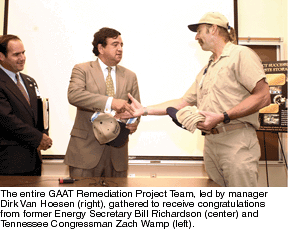 The
GAAT cleanup is not only a major milestone on ORR’s tank closure
path but also a noteworthy achievement in lowering risks to human
health and the environment. The use of robotics helped ORNL reduce
the overall GAAT remediation baseline schedule by about 12 years and
avoid approximately $135 million in costs.
The
GAAT cleanup is not only a major milestone on ORR’s tank closure
path but also a noteworthy achievement in lowering risks to human
health and the environment. The use of robotics helped ORNL reduce
the overall GAAT remediation baseline schedule by about 12 years and
avoid approximately $135 million in costs.